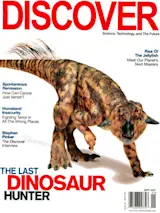Last December, DISCOVER celebrated three researchers for the remarkable ways they were changing the world and our place in it. We named Jay Keasling, a pioneer in synthetic biology, our Scientist of the Year; neuroscientist John Donoghue and geneticist Svante Pääbo were runners-up. When we recently checked back with them, each had already pushed his work into new, even bolder territory.
Jay Keasling When he received his DISCOVER award, Keasling was rejiggering microbes’ DNA to manufacture a cheap, effective treatment for malaria. Now the Department of Energy has given Keasling another world-rescuing task: Engineer similar microbes to spit out environmentally friendly fuel. As director of the new DOE Joint BioEnergy Institute at the Lawrence Berkeley National Laboratory in California—one of three upcoming national Bioenergy Research Centers—Keasling will head the institute’s efforts to support President Bush’s goal of reducing U.S. gasoline consumption by 20 percent within 10 years. “We can use ...














